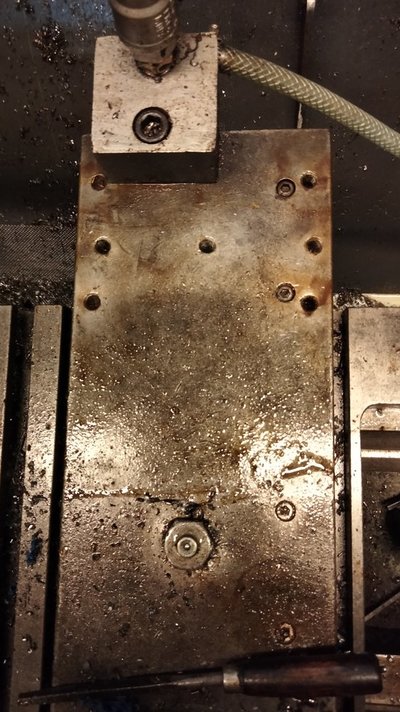- Forums
- Tools, Compressors and Metal Coatings
- Tools, Materials and Techniques
- Machining
- Lathes and other Machining Equipment
You are using an out of date browser. It may not display this or other websites correctly.
You should upgrade or use an alternative browser.
You should upgrade or use an alternative browser.
Parting off tools and holders
- Thread starter hooblah
- Start date
Agroshield
Member
- Messages
- 6,252
The inserted type are, to be sure, more money than a traditional HSS blade.
To use the traditional type successfully, you need to source a piece of good quality HSS, narrow but deep and with the correct hollow or tapered grind on it. Finding this is not so easy now. Lots of people sell things that look similar, but the tool steel is poor, the blade is too shallow (or too wide for its depth) or the grind is not right.
Once you have that, you need a holder that will support the blade rigidly and properly such that the tapered grind gives clearance on both sides of the blade. Again, good holders that do this out of the box are diffcult to find off the shelf. You can modify some with a couple of horizontal grub screws to support the bottom of the blade in the correct position.
Then you need the skills to grind the initial cutting edge on the blade and keep it touched up in the future. As the blade is tapered (getting narrower the further down you go), you need to take care that the cutting edge is always at the top of the blade. If not, as you push it in, the cutting edge will be narrower than the shank of the tool, which is not so good. The rear post is good as it angles the blade, so you do not need to grind top rake into it and thus avoids the width issue.
You will get good results if you invest the time in these things and you will have a skill that many do not have. For a Myford, the George Thomas book(s) have very good advice on parting.
On the other hand, with an inseted type: buy a 2mm GTN-type from ArcEuro, set it up on centre height, use it, change the tip once a year. The big advantage of the inserted type is the shape of the insert squashes the chip so it ends up narrower than the groove being cut and thus does not get jammed.
To use the traditional type successfully, you need to source a piece of good quality HSS, narrow but deep and with the correct hollow or tapered grind on it. Finding this is not so easy now. Lots of people sell things that look similar, but the tool steel is poor, the blade is too shallow (or too wide for its depth) or the grind is not right.
Once you have that, you need a holder that will support the blade rigidly and properly such that the tapered grind gives clearance on both sides of the blade. Again, good holders that do this out of the box are diffcult to find off the shelf. You can modify some with a couple of horizontal grub screws to support the bottom of the blade in the correct position.
Then you need the skills to grind the initial cutting edge on the blade and keep it touched up in the future. As the blade is tapered (getting narrower the further down you go), you need to take care that the cutting edge is always at the top of the blade. If not, as you push it in, the cutting edge will be narrower than the shank of the tool, which is not so good. The rear post is good as it angles the blade, so you do not need to grind top rake into it and thus avoids the width issue.
You will get good results if you invest the time in these things and you will have a skill that many do not have. For a Myford, the George Thomas book(s) have very good advice on parting.
On the other hand, with an inseted type: buy a 2mm GTN-type from ArcEuro, set it up on centre height, use it, change the tip once a year. The big advantage of the inserted type is the shape of the insert squashes the chip so it ends up narrower than the groove being cut and thus does not get jammed.
prepman
Forum Supporter
- Messages
- 2,757
- Location
- Gwynedd UK
For the ML7 I used the Cobolt HSS 'T' section one (from RDG?). Was excellent. But don't seem to be able to get in a larger size for the Student. So I ended up with Iscar, after disappointing results with alternatives including cheapo Chinese insert holders. If you decide to try an insert type, beware of the holders that just have a taper and no anvil. Stops the insert from splaying the holder. I thought I'd bought the 1st image and 2nd image arrived. Refunded.I need a parting off tool for my ML7. Is it worth going for the blade type with removable inserts? It seems like a costly way to go about it.
All the more expensive holders do a similiar approach with some form of stop. Only the dirt cheap ones don't
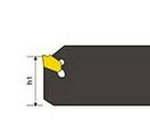
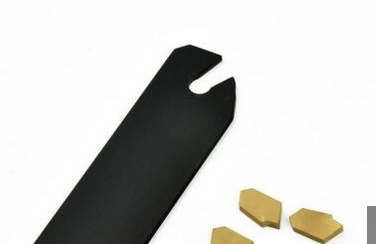
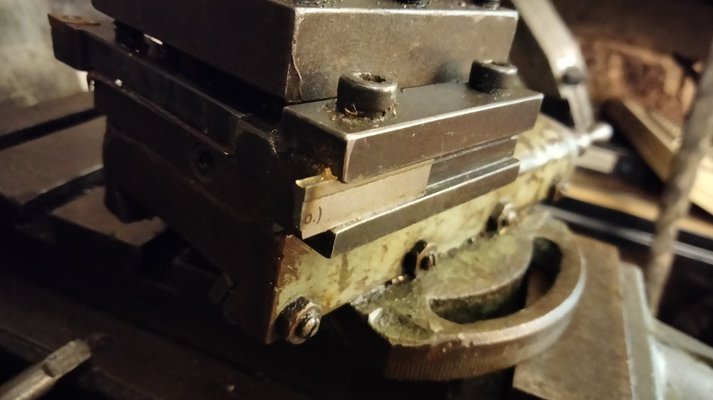
Last edited:
I use HSS blades on my Boxford. If you do go down this route buy a decent holder and remember that blades which are slightly taller than you holder can be ground down height wise (top edge) to fit.
I buy quality 3/4 and 7/8" blades when I find them cheap at car boot sales and auto jumbles. Grind the top edge down to fit my 17mm height requirement on a linisher.
I buy quality 3/4 and 7/8" blades when I find them cheap at car boot sales and auto jumbles. Grind the top edge down to fit my 17mm height requirement on a linisher.
Pete.
Member
- Messages
- 14,985
- Location
- Kent, UK
I would not use a HSS blade over an insert blade unless I absolutely had to. I have 2mm and 3mm inserts, I use the 2mm for up to about 2" diameter because it saves stock and 3mm for deeper cuts.
I modified my Chinese QCTP HSS blade holder to hold the 3mm insert blade and it works bloody great.
I modified my Chinese QCTP HSS blade holder to hold the 3mm insert blade and it works bloody great.
I got mine from Chronos and find they work well on my little hobbymat too, I use a 2mm x 10mm blade on a 5/16"square shankFor the ML7 I used the Cobolt HSS 'T' section one (from RDG?). Was excellent. But don't seem to be able to get in a larger size for the Student. So I ended up with Iscar, after disappointing results with alternatives including cheapo Chinese insert holders. If you decide to try an insert type, beware of the holders that just have a taper and no anvil. Stops the insert from splaying the holder. I thought I'd bought the 1st image and 2nd image arrived. Refunded.
All the more expensive holders do a similiar approach with some form of stop. Only the dirt cheap ones don't
View attachment 349693View attachment 349694View attachment 349709
New Clamp Type Parting Tools with Chipbreaker Blade (5% cobalt)
New Clamp Type Parting Tools with Chipbreaker Blade (5% cobalt) from Chronos, with Free UK delivery and great worldwide delivery rates. Chronos Engineering tools.
 www.chronos.ltd.uk
www.chronos.ltd.uk
prepman
Forum Supporter
- Messages
- 2,757
- Location
- Gwynedd UK
That's it Chronos not RDG....eBay history didn't go back far enough.I got mine from Chronos and find they work well on my little hobbymat too, I use a 2mm x 10mm blade on a 5/16"square shank
New Clamp Type Parting Tools with Chipbreaker Blade (5% cobalt)
New Clamp Type Parting Tools with Chipbreaker Blade (5% cobalt) from Chronos, with Free UK delivery and great worldwide delivery rates. Chronos Engineering tools.www.chronos.ltd.uk
Agroshield
Member
- Messages
- 6,252
...I use a 2mm x 10mm blade on a 5/16"square shank
That is the difficulty with the blades: they are very shallow compared to their width. This increases deflection and reduces useable stickout and hence the diameter of stuff you can cut. You could roughly work on a stickout equal to the blade depth, so the cutting force goes at 45 degrees back into the holder.
Compare and contrast typical HSS blade 2mm x 10mm deep and 2mm inserted tool 2mm x 19.5mm deep (https://www.arceurotrade.co.uk/Cata...ng-Tools/ARC-NCIH-Part-Off-Blade-Tool-Holders). Since stiffness increases with the cube of depth, that is a big difference.
don't know what you mean,That is the difficulty with the blades: they are very shallow compared to their width. This increases deflection and reduces useable stickout and hence the diameter of stuff you can cut. You could roughly work on a stickout equal to the blade depth, so the cutting force goes at 45 degrees back into the holder.
Compare and contrast typical HSS blade 2mm x 10mm deep and 2mm inserted tool 2mm x 19.5mm deep (https://www.arceurotrade.co.uk/Cata...ng-Tools/ARC-NCIH-Part-Off-Blade-Tool-Holders). Since stiffness increases with the cube of depth, that is a big difference.
thats 60mm diameter EN3 bar on my hobbymat, which isnt the most sturdy of lathes
Thanks all. All i've ever used are the hss type parting tools on proper lathes. My myford came with a hss parting tool, but I haven't used it. I'm upgrading the tool post to a gib type which I got from banggood.
Why is it recommended to use the parting tool on a rear tool post?
I'm not sure of what the motor is rated at, but i'll probably run a 2mm gtn insert. I imagine that it would have an easier time dealing with a 2mm cut.
Thanks to whoever mentioned arceuro. I was struggling to find somewhere other than china to order from for a reasonable price. Looks like I can get the whole lot together instead of having to order everything separately as well.
 www.arceurotrade.co.uk
www.arceurotrade.co.uk
Why is it recommended to use the parting tool on a rear tool post?
I'm not sure of what the motor is rated at, but i'll probably run a 2mm gtn insert. I imagine that it would have an easier time dealing with a 2mm cut.
Thanks to whoever mentioned arceuro. I was struggling to find somewhere other than china to order from for a reasonable price. Looks like I can get the whole lot together instead of having to order everything separately as well.
SLTBN Part Off Blade Tool Blocks with Blade - Arc Euro Trade
SLTBN part off tool blocks with NCIH self-locking parting blades and GTN inserts. Sizes: 6-16mm shank, blades for 2mm & 3mm GTN inserts
brightspark
Member
- Messages
- 41,356
- Location
- yarm stockton on tees
i just bought the tool holder and cut a section out of a carbide saw blade to fit making my own. just touched the tip up on a green wheel on the grinder
Mr Fro
Member
- Messages
- 501
- Location
- Bury st Edmunds-ish
I don't know if there is a "proper" reason but I had to make 49 little tapered pins the other day and constantly winding the carriage back and forth then changing the tool holder to part each one off was a pain.Why is it recommended to use the parting tool on a rear tool post?
If I'd had a rear parting blade then I could have set it to cut the right length of pin by just winding the cross slide out and not mess about with the tool holders.
Oh yeah, and I left the top slide at the taper angle (15 degrees) during parting and it juddered a bit so the rear mount would have been more solid. It was the Warco lathe at work mind...
brightspark
Member
- Messages
- 41,356
- Location
- yarm stockton on tees
the tip wont dig in using the cutting tool upside down from the rear grit your teeth if it does cutting from the frontWhy is it recommended to use the parting tool on a rear tool post?
prepman
Forum Supporter
- Messages
- 2,757
- Location
- Gwynedd UK
Also those holders for the inserts are not shouldered so all the force goes on the lower section, whereas with your setup you have the full depth of the blade.don't know what you mean,
thats 60mm diameter EN3 bar on my hobbymat, which isnt the most sturdy of lathes

The rear toolpost is something I haven't tried or have. But I can visulise the benefits. The extra rigidity comes from it being mounted directly on the cross-slide, so that also does away with the toolpost side overhang. The tool is downwards cutting, which will assist swarf removal, unless you run lathe in reverse, which is unwise on a RH screwed on chuck. The action will try to lift the rear of the saddle which is pretty tight with the gib strip. On my Colchester there is significant lift in the front of the saddle, but the locking clamp, which stops sideways movement also stops that. However the action is still a downwards force and still equates to lifting the rear of saddle.Thanks all. All i've ever used are the hss type parting tools on proper lathes. My myford came with a hss parting tool, but I haven't used it. I'm upgrading the tool post to a gib type which I got from banggood.
Why is it recommended to use the parting tool on a rear tool post?
I'm not sure of what the motor is rated at, but i'll probably run a 2mm gtn insert. I imagine that it would have an easier time dealing with a 2mm cut.
Thanks to whoever mentioned arceuro. I was struggling to find somewhere other than china to order from for a reasonable price. Looks like I can get the whole lot together instead of having to order everything separately as well.
SLTBN Part Off Blade Tool Blocks with Blade - Arc Euro Trade
SLTBN part off tool blocks with NCIH self-locking parting blades and GTN inserts. Sizes: 6-16mm shank, blades for 2mm & 3mm GTN insertswww.arceurotrade.co.uk
No doubt there is an aficionado who will be able to expand on this?
NB. Think I've just convinced myself to make one.
prepman
Forum Supporter
- Messages
- 2,757
- Location
- Gwynedd UK
Addendum....rear toolpost also
Trying to work out exactly how its attached. I don't intend to make the tee base. Just mount it directly to take the Iscar Tangrip holder. Nothing else. Manual shows only 2 bolts holding base?? Someone on hobby-machinist is making an elaborate one using 6 of the threaded holes and a Tee base.
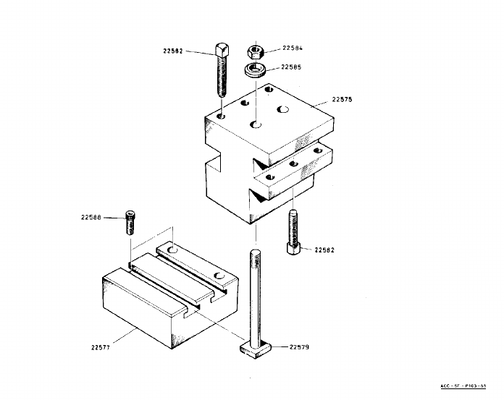
And it also removes the top-slide from the equation along with any associated play.NB. Think I've just convinced myself to make one.
Good, I doubt you will regret it.
The carriage lock on my lathe (always engaged for parting - and most facing operations, too) clamps on the rear way rail. That prevents any tendency to lift.There is no cutter overhang for tool leverage problems, the cutter is as close to central, over the cross slide as I can arrange. All in all the best geometry I can provide (my toolpost is a QC variety, so cutter overhang/extension is always something to keep ‘as reduced as possible’).
Most problems with surface finish are resolved by operator adjustments. Parting is not usually considered for the finish - but the same things still apply.
Trying to work out exactly how its attached. I don't intend to make the tee base. Just mount it directly to take the Iscar Tangrip holder. Nothing else. Manual shows only 2 bolts holding base?? Someone on hobby-machinist is making an elaborate one using 6 of the threaded holes and a Tee base.

Last edited:
prepman
Forum Supporter
- Messages
- 2,757
- Location
- Gwynedd UK
On the Mk1 Student there are no tee slots on the cross-slide. There are on the saddle. Only threaded holes. I've utilised one for the suds. There are forum members who have Students. Whether any use a rear toolpost I don't know?Mine has a main bolt from top to T nut in the cross slide and another, shorter bolt through an extension to the base. Both T-nuts are in the same slot. I keep it at the back of the cross slide, but have to be careful that the cutter will reach past the centre (or less, if there is a hole through the part) before the feed screw reaces its end of travel - a disaster for something if that were to occur while under power feed!
I’m guessing the feed post is in two parts with suitable shimming between, to achieve centre height.
Mine is at centre height, for my lathe, and the cutter obviously extends perfectly in a horizontal plane, so I’ve never needed to look, check or fiddle. It just works. Sharpen the blade (about 20mm deep?), select power feed and concentrate on lubrication until the item falls off.
The only thing to sometimes check/set is that the blade is not deflected at all, if cutting deep. I sometimes widen the kerf a little, if I am not totally sure. Apart from taking those perfectly reasonable steps, parting works fine on my over 50 year-old hobby lathe.
Maybe some kind soul will shout out?
